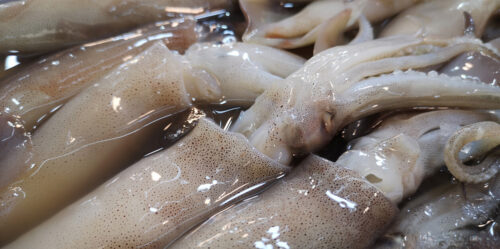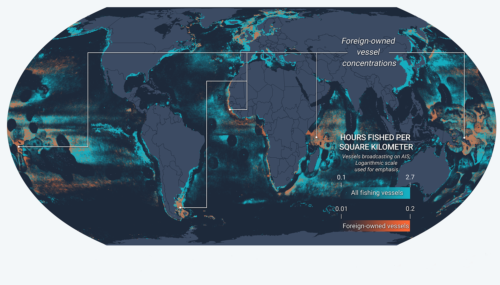If you’ve grown accustomed to the idea that everything in our world is traceable—from airplanes to cell phones to personal browsing history and purchasing habits—it may seem like a no-brainer that we can use publicly broadcast Automatic Identification System (AIS) signals from ships at sea to find out where they are and what they’re doing. But in fact, it takes a lot of brains, both human and machine.
Over a given 24-hour period, there may be 27,000 or more vessels broadcasting AIS messages as often as every five seconds. The capacity for mass detection of that many signals has only become feasible in the last few years with the steady increase in the number of satellite receivers.
“We received over 4.5 billion [AIS] messages since mid-2015,” says Aaron Roan, our data scientist from Google, “We’re now receiving about 600 million messages a month, and there’s a steady trend upward of satellites being launched in 2012, 2014, 2016.” In the spring of 2016 there were around 28 satellites in low-earth orbit capable of receiving AIS messages. Roughly 60 more are planned for launch in coming years.
Aaron had never worked in fisheries or ocean issues before jumping on the Global Fishing Watch project, so for him this was an exciting chance to work in a new field on a new dataset that had never been explored. “My first thought was; wow, there’s a whole world out there that we don’t see. Seventy percent of Earth’s surface is covered by ocean, and we can only see that small part near land, but we’re starting to be able to see all of it with satellites and computer analysis.”
Recently he’s been working with the AIS data to identify transhipment at sea (the transfer of goods from one vessel to another). It poses a serious problem for traceability issues in the seafood market, because it enables criminals to launder their illegal catch by mixing it with legally caught fish. That’s why transhipment is prohibited in most places, but like everything else over the horizon, it’s nearly impossible to see.
Aaron and Global Fishing Watch data analyst Nate Miller are trying to find characteristics in the AIS messages that can be used to identify transshipment. “If we can get enough examples of transshipment, we can feed it to our machine learning experts, and we can start training our algorithms.”
There’s more about how we’re using machine learning in our previous post, but the basic idea is that the computer model they are developing uses those characteristics to filter out AIS messages that aren’t from transshipping vessels. The model applies the filters to the data in layers until what’s left is a set of AIS messages from vessels that may be engaged in transshipment.
“One of the things that’s so cool about this is that with most machine-learning projects it’s really about the corporate space—understanding social graphs or understanding economics. A smaller subset of machine-learning is about good causes, and an even smaller subset is focused on environmental causes. And probably the smallest of environmental causes is oceans, because the data just hasn’t been there. This is an untapped world of data that’s not being looked at. Add to that the fact that we’re doing something that is making a difference on so many levels, it really feels like we’re having a huge positive impact.”
Aaron says he’s excited about scaling up what we’re doing. He hopes to enable other analysts to work with the data through Google Earth Engine and other Cloud platforms. “I want to share this data,” he says. “There are limitations to that, because the data is licensed, but I want to set up an infrastructure so that what we can share can be shared really well. I want to help guide that so that as new analysts come on—analysts from the other side of the world that I’ve never met who don’t even speak the same language—are able to add layers that give them a lot of other insights to things that are relevant to them. It’s about using the data to reach for a true understanding of fishing and of the ocean.”

